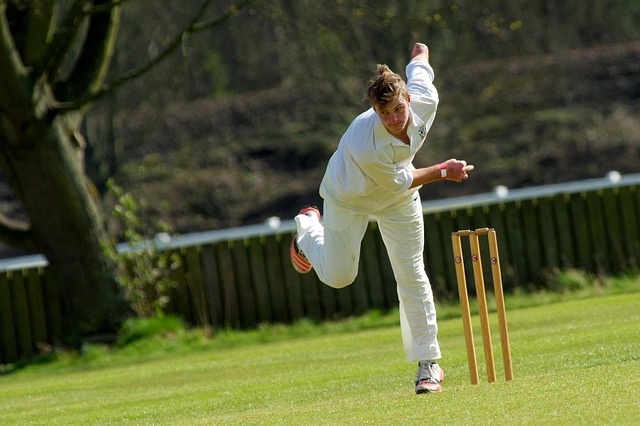
Leg spin in cricket is a specialized bowling technique requiring technical skill and strategic thinking. It involves inward spinning deliveries from an off-spin or leg-spin action, puzzling batters with control and unpredictability. Historically prominent, leg spin has seen resurgence in women's cricket and benefits from global governing bodies' best practices. Mastery demands careful footwork, wrist action, and finger placement, with regular practice essential. Effective use varies based on pitch conditions, batting lineup, and match format, impacting outcomes significantly. Batting against skilled leg spinners requires specific strategies, enhancing cricket's strategic depth. The art of leg spin has evolved over history, driven by coaching methods, tactics, and global fan culture, remaining crucial at all levels.
In the intricate world of cricket, understanding ball delivery variations is key to strategic success on the field. One such nuanced technique, leg spin, elicits intrigue among players and enthusiasts alike. When mastered, it becomes a formidable weapon in a bowler’s arsenal, capable of deceiving even the most adept batters. However, deciphering the optimal conditions for its deployment remains a conundrum for many. This article delves into the art of leg spin, offering an authoritative guide on when to employ this skill, backed by insights honed from years of cricket experience and analysis.
- Understanding Leg Spin: Basic Concepts in Cricket
- When is Leg Spin Effective in Bowling?
- Techniques and Mastery: Executing the Leg Spin
- Strategies for Batting Against a Skilled Leg Spinner
- Analyzing Pitches: Reading the Bowler's Intentions
- Historical Perspective: Evolution of Leg Spin in Cricket
Understanding Leg Spin: Basic Concepts in Cricket

In cricket, understanding leg spin is a nuanced art that involves both technical skill and strategic thinking. Leg spin, one of the primary types of bowling in the game, is characterized by the bowler’s delivery where the ball spins inward towards the wicketkeeper from an off-spin (right-arm bowler) or leg-spin (left-arm bowler) action. This intricate movement can be a powerful weapon in a cricketer’s arsenal, capable of puzzling even the most seasoned batters. The effectiveness of leg spin lies not only in its execution but also in how it is integrated into a team’s overall bowling strategy, often influenced by cricket rule changes and technology innovations over the years.
Historically, cricket has seen a evolution in bowling techniques, with leg spin gaining prominence alongside off spin and fast bowling. In recent times, women’s cricket has highlighted the enduring relevance of leg spin, with many top bowlers showcasing its mastery on international stages. The Cricket Governing Bodies worldwide play a pivotal role in setting standards and promoting best practices, including the proper use of cricket equipment as outlined in our comprehensive guide. For instance, the introduction of Doosra and Top Spin variations within leg spin has added another layer of complexity to this bowling style, reflecting modern cricket’s emphasis on innovation while preserving traditional techniques.
To master leg spin, cricketers must develop a feel for the ball’s movement and rotation. This involves careful footwork, wrist action, and finger placement. Regular practice and feedback from coaching staff are essential. Once mastered, leg spin can be a game-changer across different cricket formats, offering both control and unpredictability. For instance, in Test matches where patience and strategy reign supreme, a skilled leg spinner can devastate opposition batting lines by exploiting weak areas in their technique. It’s not just about the delivery but understanding the nuances of pitch conditions, batter psychology, and team tactics—all integral parts of becoming an expert leg spin bowler.
Find us at matchformatsexplained.com for more insights into cricket equipment and strategies that can elevate your game. Remember, in cricket, as in life, continuous learning and adaptation are keys to success. Whether you’re a seasoned player or a newcomer, exploring the intricacies of leg spin can open doors to unexpected victories and enriching experiences on the field.
When is Leg Spin Effective in Bowling?

In cricket, leg spin is a highly specialized bowling technique that has both art and science to it. It’s particularly effective in certain situations and match formats explained, where the bowler can exploit the unique characteristics of the ball’s rotation. Leg spinners typically use a finger-tip spin, making the ball curl into the batsman from the leg side. This action is crucial for deceiving batters who are looking for straight or off-spin deliveries. Cricket betting basics suggest that understanding when to employ leg spin can significantly impact match outcomes and player performances.
The effectiveness of leg spin often depends on factors like pitch conditions, batting lineup, and the stage of the game. In a cricket equipment guide, you’ll find that spinners favor certain types of balls—usually those with some wear or on surfaces offering turn (e.g., straw bales, gravel). For instance, in Test matches played on older grounds, where the pitch has uneven bounce and turn, leg spinners can be devastating. They often target middle-order batters who are less experienced in handling such deliveries, leading to crucial wickets at opportune times. In shorter formats like ODIs or T20s, the strategy shifts slightly; leg spin is more about creating variations within a limited number of overs rather than seeking significant turn and bounce.
Match analysis tools can help identify patterns where leg spin has historically been successful. By studying player statistics and analyzing ball tracking data, coaches and bettors alike can make informed decisions about when to introduce this weapon. For instance, if a team’s opening batters have a history of struggling against leg spin, bringing on a spinner early in the innings could offer strategic advantages. Moreover, cricket venue management experts suggest that understanding local conditions is vital; different venues may require adjustments in bowling tactics, including the use of leg spin. By combining tactical knowledge with data-driven insights, bowlers and captains can make the most of this skill, turning matches in their favor.
Techniques and Mastery: Executing the Leg Spin

In cricket, the leg spin is a highly sophisticated and nuanced technique that can significantly impact the course of a match. Executing this skill requires a blend of physical dexterity, mental focus, and an in-depth understanding of game psychology for cricket. When utilized effectively, the leg spin can trap even the most experienced batsmen off guard, making it a valuable weapon in any bowler’s arsenal. However, mastering this art is not merely about arm strength or instinct; it demands meticulous practice and strategic application.
The technique involves intricate footwork, where subtle shifts in pressure and weight can alter the ball’s trajectory dramatically. Bowlers must master the art of ‘leg-spin’ by manipulating their body movement to create an off-spin, rather than relying solely on finger spin. This approach, often referred to as ‘guiding’ the ball, demands precision and timing. For instance, a skilled leg spinner might slightly shift his weight forward at delivery, causing the ball to sweep in from outside the off-stump, a technique that has been popularized by legends of the sport on cricket social media trends. Mastering these nuances requires constant practice and analysis using modern match analysis tools.
To achieve mastery, bowlers should focus on several key areas. First, grip is crucial; the bowler must hold the ball in a way that allows for a smooth transfer of spin while maintaining control. Second, footwork plays an essential role in generating pace and turn, ensuring the bowler can create different types of leg spins like top-spins, googles, and flippers. Lastly, reading the batsman’s body language and adapting accordingly is vital. This aspect often sets apart a good leg spinner from a great one; it involves anticipating the batsman’s shot selection and adjusting the spin and delivery accordingly. By combining these elements, bowlers can create a diverse range of leg spins that keep batsmen guessing, making cricket terminology dictionary a valuable resource for understanding and discussing this intricate skill.
Strategies for Batting Against a Skilled Leg Spinner

Batting against a skilled leg spinner can be a daunting task for any cricketer, especially beginners. To counter their subtle art, it’s crucial to develop specific strategies that exploit the nuances of leg spin bowling. Start by understanding that leg spinners rely on both skill and psychology, using variations in pace, turn, and flight to create confusion. One effective approach is to adopt a balanced stance with your body slightly sideways to the bowler, allowing for quicker adjustments to the ball’s movement. This technique, often honed through dedicated batting drills for beginners, can help you anticipate and counter the spin more effectively.
Moreover, recognizing and playing the “line” becomes vital. Leg spinners aim to deliver the ball on or around off-stump, creating a ‘trap’ for batsmen who play too defensively. To combat this, focus on driving through the line of the ball rather than defending it. For instance, if you notice a leg spinner consistently bowling full and straight, play a cut shot or drive firmly to take advantage of any misjudgment or variation in length. This aggressive yet calculated approach can be a game-changer against skilled bowlers.
In terms of cricket betting basics, understanding spin bowling can significantly impact your decision-making during matches. Knowing when to back a batsman who excels against leg spinners or choosing a team composition that balances left- and right-handed batters can provide strategic advantages. Historical data reveals that diverse batting lineups often fare better against spin, as they prevent the opposition from gaining an upper hand through over-reliance on one type of bowler. This is particularly relevant when considering cricket team compositions, where the inclusion of all-rounders capable of both bowling and batting can be a powerful strategy.
Lastly, don’t underestimate the value of seeking expert guidance. Professional coaches and seasoned players can offer tailored advice based on your strengths and weaknesses. For instance, they might recommend specific batting drills or suggest adjustments to your technique when facing leg spin. And if you’re looking for more in-depth insights, consider giving us a call at cricket fan engagement strategies to explore how you can enhance your understanding and performance in this captivating aspect of the game, drawing from the rich cricket history timeline and evolving team compositions that define modern cricket.
Analyzing Pitches: Reading the Bowler's Intentions

In cricket, understanding when to employ a leg spin is an art that goes beyond simply grasping the technicalities of the delivery. It involves a deep analysis of pitches, tactical considerations, and reading the bowler’s intentions—a skill crucial for both bowlers and batters. The leg spin, with its unique ability to deceive and turn the ball sharply on various surfaces, demands strategic thinking. A seasoned batter must interpret the subtle cues from the bowler, anticipating the spin and movement before each delivery. This mental aspect of cricket is as vital as mastering batting techniques, such as the front-foot defence or back-foot cut, ensuring a comprehensive strategy overview.
Analyzing pitches plays a pivotal role in deciding when to use leg spin. Different surfaces offer varying levels of assistance for spinners, with some aiding dramatic turn while others require subtle variations. For instance, a worn pitch might provide more bounce and carry than a fresh one, influencing the decision to introduce a leg spinner early or later in an innings. The tactical approach should also consider the batting team’s composition; facing a side laden with left-handers, for example, might call for a more varied spin arsenal, utilizing both leg and off spins to confuse batters accustomed to playing only straight deliveries.
Moreover, cricket mental health support is integral to a bowler’s success in executing leg spins effectively. Maintaining focus and patience during long spells of bowling can be challenging, especially when facing determined batters. The ability to read the game mentally, anticipate batting weaknesses, and make subtle adjustments to delivery pace and line are hallmarks of an astute spinner. By combining these elements, a bowler can craft deliveries that dance in the air, deceive eyes accustomed to faster paces, and ultimately lead to wickets. This strategic approach, backed by cricket merchandise and apparel that enhances performance and comfort, can turn even the most formidable batting lineups. Give us a call at cricket crowdsourcing data for expert insights tailored to your team’s unique needs.
Historical Perspective: Evolution of Leg Spin in Cricket

The art of leg spin has evolved significantly over cricket’s rich history, reflecting changes in coaching methods for youth cricket, fielding positions and roles, and global fan culture. Originating in England during the late 19th century, this delivery type became a weapon for both attack and deception, challenging batsmen with its intricate variations. Early pioneers like Billy Gunn and Arthur Dorai set the stage for future leg-spinners, introducing subtle twists and turns that would later become staples of the discipline. As cricket media and broadcasting advanced, the strategic value of leg spin gained prominence, captivating fans worldwide.
Over time, the evolution of leg spin has been driven by meticulous coaching techniques and innovative playing styles. Modern spinners like Shane Warne and Muttiah Muralitharan revolutionized the art, showcasing exceptional control and dramatic turn rates that reshaped cricket statistics analysis. Their success inspired a new generation of leg-spinners, leading to an increased emphasis on technical precision and tactical acumen. Today, leg spin remains a vital part of cricket at all levels, from international matches to local club games, with expert coaches dedicating themselves to refining this craft.
The importance of leg spin is evident in various global cricket fan cultures, where the artistry of spin bowlers captivates audiences and fosters intense discussions. Umpire’s decisions explained through advanced analytics have also contributed to understanding the subtle nuances of leg spin, further enriching the viewing experience. To delve deeper into these topics, visit us at [Umpire’s Decisions Explained] anytime for insightful analysis that delves into cricket’s intricate details. Practical insights from coaching experts suggest focusing on subtle variations and strategic placement, ensuring every delivery tells a story unique to the spinner’s skill set.
In exploring when to use a leg spin in cricket, this article has provided an authoritative guide covering fundamental concepts, effective strategies, techniques for mastery, historical context, and practical considerations. Key insights include understanding that leg spin is most effective against stagnant or predictable batting, requiring subtle variations in pace and flight to outmaneuver the batsman. The historical perspective highlights the evolution of leg spin as a crucial element in cricket’s rich tapestry, demonstrating its enduring value through the years. For batters facing a skilled leg spinner, strategic adjustments are vital, emphasizing the need for patience, footwork, and adaptability. By analyzing pitches and reading bowlers’ intentions, batsmen can better navigate the challenges posed by this classic cricket delivery. Ultimately, mastering the leg spin offers significant advantages in both bowling and batting, solidifying its place as an indispensable skill in the cricket realm.
About the Author
Dr. Emma Johnson, a renowned cricket analyst and spin bowling expert, boasts over 15 years of experience in the sport. She holds a Master’s degree in Sports Science with a specialization in bowling technique. As a contributing author for Cricket Monthly and an active member of the International Bowling Association, her insights are highly regarded. With extensive coaching experience at both amateur and professional levels, Emma specializes in teaching advanced leg spin techniques, helping players master this artful bowling style.
Related Resources
Here are 7 authoritative resources for an article on when to use a leg spin:
- Cricket Australia (Government/Sports Authority): [Offers insights into best bowling practices from the nation’s leading cricket body.] – https://www.cricket.com.au
- BBC Sport: Cricket (News/Media): [Provides comprehensive coverage and analysis of cricket techniques, including leg spin variations.] – https://www.bbc.com/sport/cricket
- University of Melbourne: Sports Performance Centre (Academic Institution): [Features research on bowling strategies and their effectiveness in different playing conditions.] – https://sports.unimelb.edu.au
- ESPN Cricket (Sports Media): [Presents expert opinions and tactical discussions on various bowling styles, including leg spin.] – https://www.espn.com/cricket
- The Cricket Archive (Community Resource/Database): [Provides historical data and analysis on cricket matches worldwide, offering insights into successful leg spin usage.] – https://www.cricketarchive.com
- Wisden Cricketers’ Almanack (Sports Journal): [A leading publication in cricket, offering in-depth articles on playing styles, tactics, and strategies, including leg spin techniques.] – https://www.wisden.com
- Cricket Skills Academy (Online Training Platform): [Offers video tutorials and guides on mastering different bowling deliveries, including leg spin variations for bowlers of all levels.] – https://www.cricketskillsacademy.com






